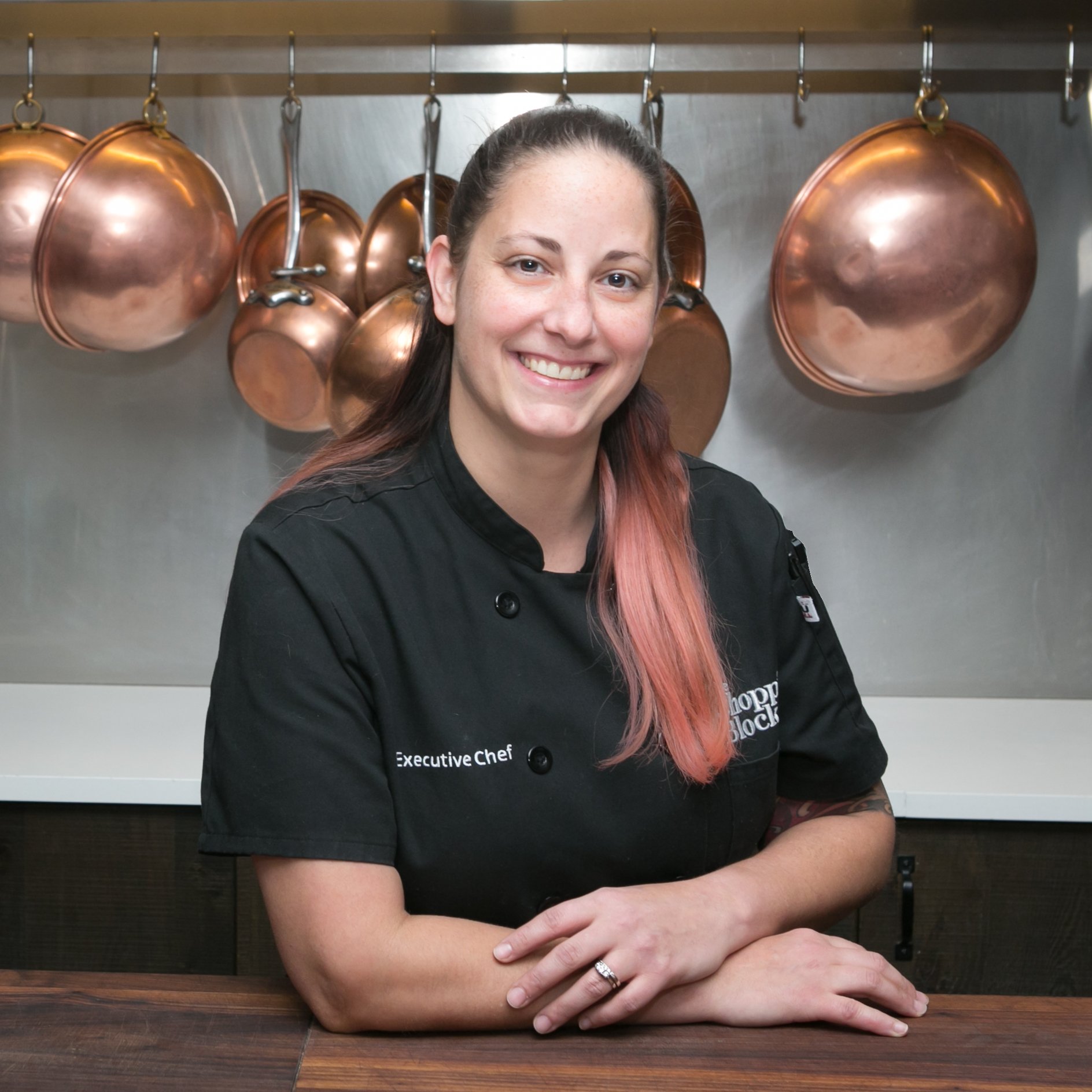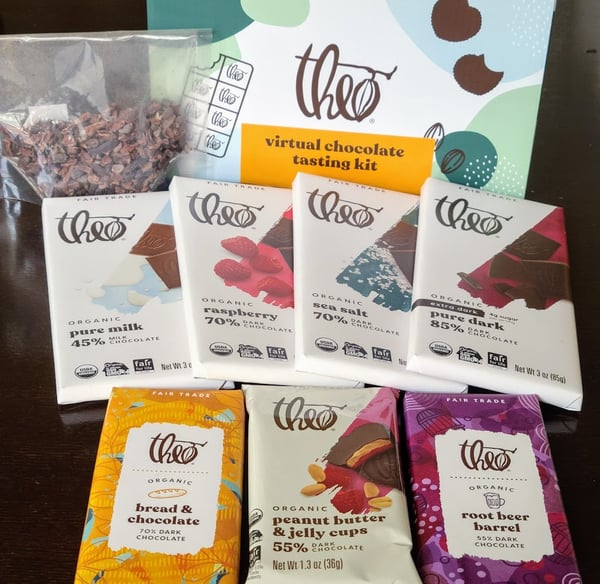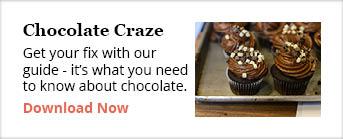I want to let you all in on a not-so-secret confession: I am a chocoholic! They say a day without chocolate is like day with no sunshine, but I wouldn’t know because I eat a bit of chocolate every day. To me, this little indulgence is good for the soul. Maybe not so great for the waistline but once that smooth, velvety, bitter and sweet nugget touches my lips and tongue, all is right in the world. If you have the same mindset and wondered why chocolate can be so addicting and nurturing, check out this chocolate craze blog to learn more about the science behind chocolate and the reactions it has on the body.
This addiction of mine started when I was about 11, when I would religiously watch the show Dessert Circus with Jacques Torres on PBS. I would recreate all of his desserts and my favorites were, of course, the chocolate ones. I am pretty sure it was right then and there that I decided I wanted to be a chocolatier. Look at how far we have come Jacque: you have another hit TV show and are the biggest name in chocolate, and I am still in love with chocolate and desserts but decided to keep my passion as a hobby instead!
I am still learning from Jacque Torres, and my latest obsession is his book A Year in Chocolate, where he gives seasonal chocolate recipes for throughout the year. There are so many things you can learn about chocolate from its rich history that all started as a beverage, all of the different kinds of chocolate, how to taste or pair chocolate, and of course, all of the different recipes to utilize this glorious product. Chocolate can be manipulated and enjoyed in various ways. From bean to bar, this is truly an amazing ingredient.
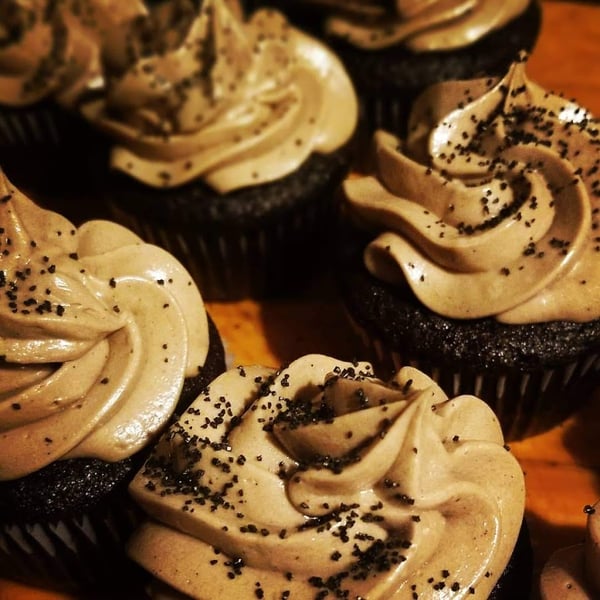 Dark and Milk Chocolate Cupcakes
Dark and Milk Chocolate Cupcakes
Types of Chocolate
- Milk Chocolate: Milk chocolate is perhaps the most popular type of chocolate. It actually contains only 10 to 40 percent cacao mixed with sugar and milk (either condensed milk or milk solids). Milk chocolate is much sweeter than dark or bittersweet chocolate and has a lighter color and less-pronounced chocolate taste. However, milk chocolate isn’t great for baking because it’s prone to overheating.
- Dark Chocolate: Dark chocolate contains chocolate liquor, sugar and cocoa butter. Dark chocolate does not contain any milk solids. The amount of cocoa in dark chocolate bars ranges from 30 percent all the way up to 80 percent.
- Semisweet Chocolate: Semisweet chocolate contains at least 35 percent cocoa solids, but there are no official guidelines that govern what can be called “semisweet.” Semisweet chocolate falls somewhere between bittersweet chocolate and sweet dark chocolate. This type of chocolate is most commonly used for baking, but it’s important to follow the recipe to determine whether it calls for semisweet, bittersweet or baking chocolate.
- Bittersweet Chocolate: Bittersweet chocolate must contain at least 35 percent cocoa according to the FDA, but most bittersweet bars contain 50 percent, with others having as much as 80 percent cocoa. This type of chocolate often has a deeper, more bitter flavor than other types of chocolate.
- Unsweetened Chocolate (or Baking Chocolate): Unsweetened chocolate is just like its name implies. It’s pure chocolate liquor, made of simply of ground cocoa beans. It’s also known as baking chocolate, because it’s not meant for consumption on its own. Instead, it’s best when used in baking or cooking and combined with other ingredients to make it taste better. Contrary to popular belief, pure chocolate doesn’t taste very good. However, it lends a deep, rich chocolate flavor to recipes and is the base of most of the other types of chocolate.
- Cocoa Powder: Cocoa powder is also comprised of 100 percent cacao with no sugar, but has had the cocoa butter extracted out. Cocoa powder is also very bitter, but is commonly used in recipes. It’s a helpful ingredient because it easily mixes in with doughs and batters without having to melt and monitor the chocolate.
- Couverture Chocolate: Couverture chocolate is an expensive type of chocolate that contains a higher percentage of cocoa butter than other varieties. The high cocoa butter content helps it melt quickly and evenly, making it perfect for tempering and making candies. You can find milk, white, and dark couverture chocolates.
- Ruby Chocolate: Ruby chocolate is the newest variety around and was first formulated in China in September 2017. It is made from ruby cocoa beans naturally found in Ecuador and Brazil, which give the chocolate its rosy hue. It is said to taste a combination of white chocolate and berries, even though there aren’t any berries in the recipe.
- White Chocolate: White chocolate does not contain chocolate liquor or any other cocoa products besides cocoa butter. It doesn’t have a very chocolatey taste, but resembles smooth vanilla. White chocolate contains a minimum 20 percent cocoa butter, a maximum of 55 percent sugar and about 15 percent milk solids. Side note: This chocoholic does not consider white chocolate to be a true type of chocolate!
Tasting Chocolate
First, the best chocolate is the one you like the most. No two people perceive aroma or taste flavors exactly the same way, and even texture can differ from one palate to another. Your individual chocolate palate evolves and sharpens over time and with experience. I love dark chocolate the best. To me, it is the most intense and strong chocolate taste you can get. It doesn’t hurt that it is the “healthiest” of the chocolates, either!
I want to give you a few tips and tricks on how to properly taste chocolate and to distinguish between quality bars and inferior products. Tasting chocolate is a full sensory experience meant to be savored and not rushed. I actually did a virtual chocolate tasting during quarantine and learned so much.
Look
We eat with our eyes. Appearance is part of the initial pleasure and attraction of chocolate, but not itself a measure of quality. The color of chocolate varies. It may be ivory, golden, shades of copper brown, deep reddish, or charcoal brown - depending on the type of chocolate, the percentage of cacao in the chocolate, the presence and quantity of milk or cream and the source of the beans from which the chocolate was made.
An attractive gloss on the surface of chocolate with a tight, fine grain and even-colored showing at cut or broken edges indicates that the chocolate was well-tempered and properly cooled and stored. Scuffed or scraped samples are not necessarily of poor quality, but they are less pleasing to the eye.
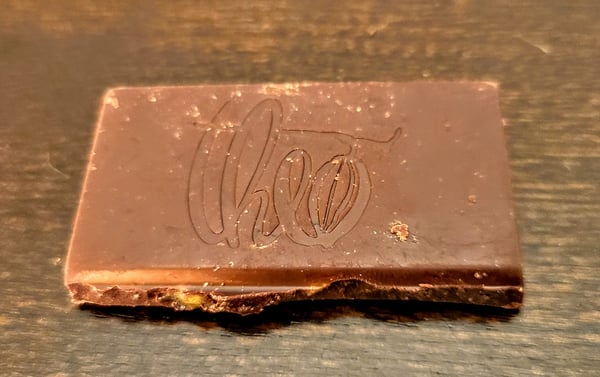 Aroma
Aroma
Before even tasting, rub the piece of chocolate with your thumb to warm and release its aroma. Hold the chocolate to your nose to capture and hold the aroma and sniff or draw slow breaths. At first chocolate may simply smell “chocolaty.” But as you compare one piece with another you will notice general differences in richness, intensity, sweetness and earthiness. You'll pick up on lower notes and higher notes. The aroma of some chocolates is faint, while that of others is intense. You may then detect even more specific differences. Milk chocolates often give off aromas of milk or cream, or caramel or malt. Dark chocolate aromas may be characterized by toasted nuts, roasted coffee, dried fruit or wine. Some chocolates have floral or fruity qualities; others smell more roasted or nutty. As with flavor, each chocolate brand has a signature aroma. This comes from the blend or selection of beans and their quality, as well as the manufacturer's roasting and conching methods.
Hear the Snap
Next, break a piece of the chocolate near your ears and listen for the snap! It's the first clue to texture. Snap is the feel and sound of a piece of chocolate when you first break it or bite into it. Snap is easier to appreciate in a thin bar than a thick chunk of chocolate. Snap is a function of the amount and quality of the cocoa butter in the chocolate, how finely ground the chocolate particles are and how well the chocolate was tempered. White and milk chocolate bars have a gentler snap than dark or semi-sweet chocolate because their milk and butter fat content make them naturally softer.
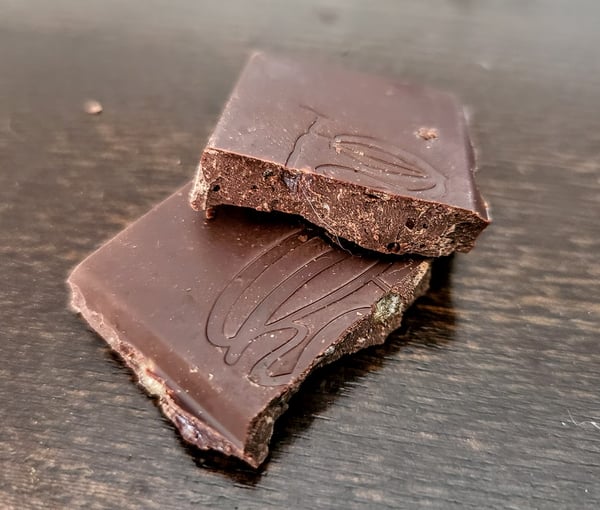 Savor the Melt
Savor the Melt
Mouthfeel is another word for texture. After looking, smelling and snapping, place the chocolate in your mouth. But, resist the urge to chew and eat. Instead, hold the chocolate against the roof of your mouth and pass your tongue over the bottom of it, noticing first how it melts and then how it feels. Does it melt readily and feel smooth and creamy, or greasy and slimy? Maybe it resists melting and seems hard or waxy? Does it feel grainy or gritty, powdery, harsh, or drying? Once the piece of chocolate has melted completely, take another piece so that you can now notice how the chocolate feels to chew. Is it gummy, sticky, cake-like, fudgy, fast-dissolving, etc.? Texture is enormously important to the chocolate experience. A smooth and creamy melt-in-your-mouth texture is so seductive, that many people are more influenced by texture than by flavor.
Taste
Flavor is the ultimate criterion for quality in chocolate. Because texture is so distracting, some tasters focus on flavor first, before considering texture. Either way, flavor begins to fill your mouth from the moment the chocolate begins to melt on your tongue. At first there is so much pleasure in tasting the chocolate, it may be difficult to focus on the specifics of flavor. As with aroma, your first perception may be simply described as “chocolaty” or even just “yummy”! As you begin to focus, notice several things: Does the flavor come on quickly or slowly? Does the flavor build and peak or remain constant? Does the flavor change character from the beginning to the middle to the end? How long does the flavor last in your mouth?
Pairing
Describing the flavor you perceive is the most fun and most challenging aspect of chocolate tasting. Everyone gets better with practice and who wouldn’t want to keep tasting in order to hone their chocolate describing skills?
To take your chocolate tasting to the next level, try pairing your chocolate with beverages. My favorite spirit to pair with chocolate is bourbon, which happens to be another obsession of mine. It works really well to bring out the caramel notes and acts as a nice palette cleanser as the chocolate melts on your tongue. When pairing red wine with chocolate, try and opt for a fruitier and not so tannic variety otherwise you could end up over drying out your mouth. Coffee and tea pair beautifully with chocolate as well. For you beer drinkers out there, pilsners go best with semi-sweet chocolate, dark chocolate works well with IPAs, and I like milk chocolate with stout beers. There are so many other chocolate matches made in heaven… maybe I will have to write a part two to this post!
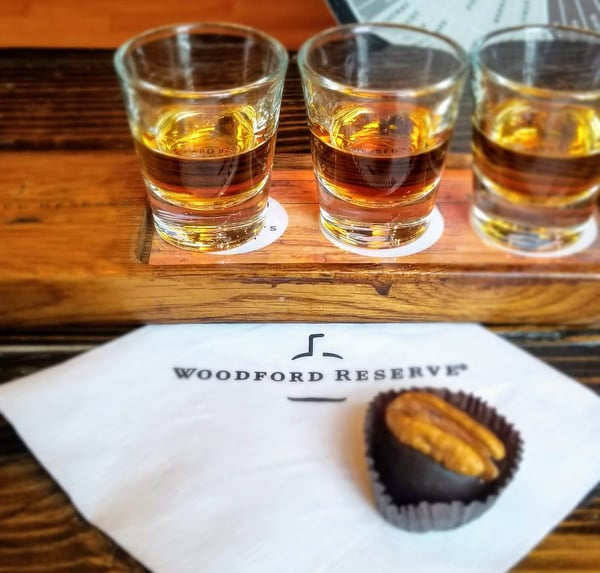 In this recipe, I wanted to use various types of chocolate in different applications to come together in harmony for one seriously delicious showstopper of a cake. I hope you all try this at least once in your life!
In this recipe, I wanted to use various types of chocolate in different applications to come together in harmony for one seriously delicious showstopper of a cake. I hope you all try this at least once in your life!
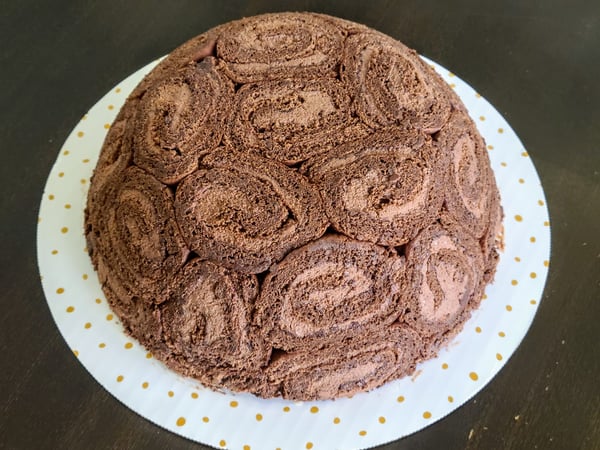
Triple Chocolate Charlotte Royale
Scroll down for a printable version of this recipe
Yield: 1 10” dome cake, serves 10-12
Active time: 1 hour
Cook time:
Total time: includes chilling time
For the chocolate cake:
Unsalted butter, softened, for the pan
1 oz. (1/4 cup) unsweetened Dutch-process cocoa powder, more for dusting
1-1/2 oz. (1/3 cup) all-purpose flour
1/8 tsp. kosher salt
6 large eggs
1/2 cup plus 2 Tablespoons granulated sugar
1 teaspoon pure vanilla extract
For the milk chocolate ganache:
10 oz. milk chocolate, finely chopped
2 oz. dark chocolate, preferably 85% cacao, finely chopped
4 oz. (8 tbs.) unsalted butter, cut into pieces
Pinch kosher salt
1 cup heavy cream
1 Tablespoon pure vanilla extract
1 Tablespoon espresso liquor
For the white chocolate buttercream:
6 oz white chocolate, chopped into small pieces
1 cup unsalted butter, softened to room temperature
2 cups powdered sugar
1/2 teaspoon vanilla extract
1/8 teaspoon salt
3 Tablespoons heavy cream
For the dark chocolate mousse:
8 oz dark chocolate, chopped
1 teaspoon gelatin
2 Tablespoons water
1/2 cup sugar
2 1/4 cups heavy cream
1/2 cup cocoa nibs
To make the cake:
1. Position a rack in the center of the oven and heat to 400°F. Butter a large rimmed baking sheet and line with parchment. Butter the parchment and dust with cocoa powder, shaking out the excess.
2. Combine the cocoa powder, flour and salt in a small bowl.
3. Separate 3 eggs. Reserve the whites in a bowl of a stand mixer.
4. Put the yolks, the remaining 3 whole eggs and 1/2 cup of the sugar in a bowl, and whisk until thick and light in color, about 5 minutes.
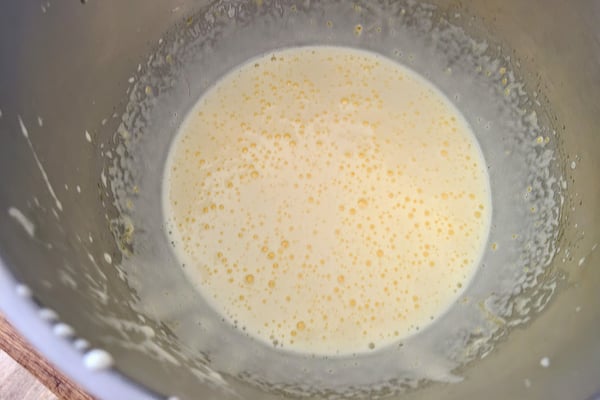 5. Sift half of the cocoa powder mixture over the eggs. Using a large silicone spatula, fold to combine. Repeat with the remaining cocoa powder mixture.
5. Sift half of the cocoa powder mixture over the eggs. Using a large silicone spatula, fold to combine. Repeat with the remaining cocoa powder mixture.
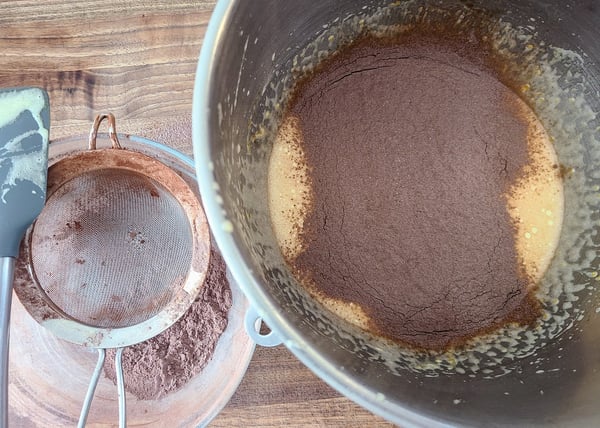 6. In a clean stand-mixer bowl with a clean whisk attachment, beat the 3 egg whites on medium speed until frothy, about 30 seconds. Add the remaining 2 Tbs. of sugar, increase the speed to medium high, and whip until medium peaks form, about 3 minutes. With a silicone spatula, fold half of the whites into the chocolate mixture to lighten. Gently fold in the remaining whites and the vanilla until the batter is evenly colored, with no streaks of white.
6. In a clean stand-mixer bowl with a clean whisk attachment, beat the 3 egg whites on medium speed until frothy, about 30 seconds. Add the remaining 2 Tbs. of sugar, increase the speed to medium high, and whip until medium peaks form, about 3 minutes. With a silicone spatula, fold half of the whites into the chocolate mixture to lighten. Gently fold in the remaining whites and the vanilla until the batter is evenly colored, with no streaks of white.
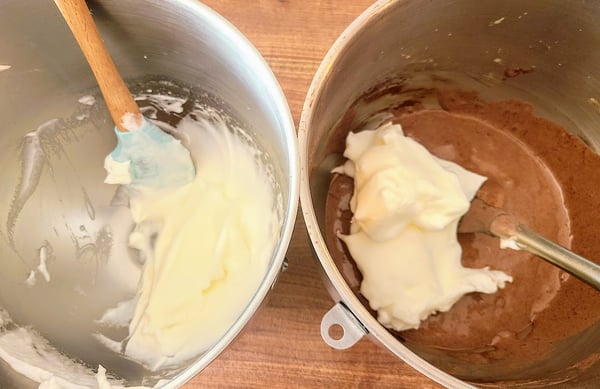 7. Scrape the batter into the prepared pan, gently leveling it with an offset spatula.
7. Scrape the batter into the prepared pan, gently leveling it with an offset spatula.
8. Bake until the cake springs back when touched in the center, about 12 minutes. Set the pan on a wire rack and allow to cool slightly.
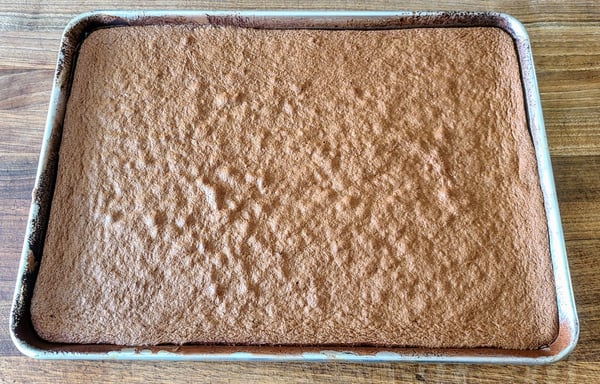 9. Run a knife between the edge of the pan and the cake. Dust the top of the cake with cocoa powder. Flip the cake onto a clean kitchen towel, peel off the parchment, and starting with a long side, roll up the cake with the towel so that you have a 16-inch-long roll. (This will help the cake roll without cracking when filled.) Let cool completely in the roll, about 30 minutes.
9. Run a knife between the edge of the pan and the cake. Dust the top of the cake with cocoa powder. Flip the cake onto a clean kitchen towel, peel off the parchment, and starting with a long side, roll up the cake with the towel so that you have a 16-inch-long roll. (This will help the cake roll without cracking when filled.) Let cool completely in the roll, about 30 minutes.
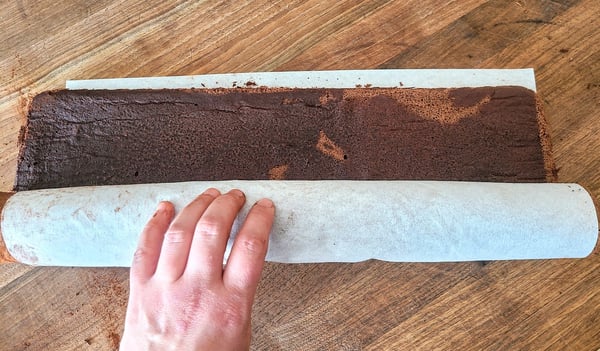 To make the Milk Chocolate Ganache:
To make the Milk Chocolate Ganache:
1. Measure the two chocolates into a bowl. Combine the salt, butter, heavy cream and vanilla in a small saucepan and bring to a simmer over medium heat.
2. Pour the hot mixture over the 2 chocolates and stir to combine until smooth. Add in the espresso liquor.
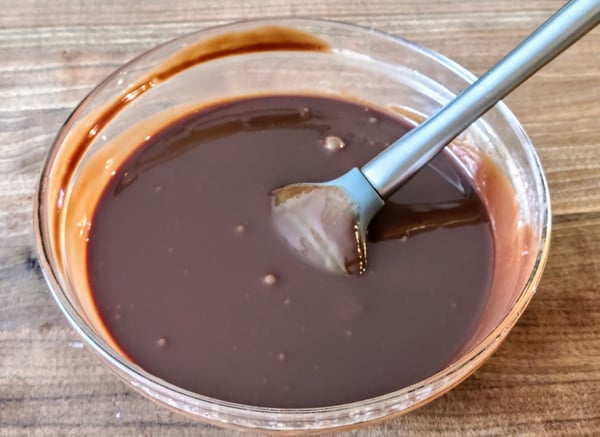 3. Refrigerate uncovered until it is the consistency of thick pudding, about 25 minutes.
3. Refrigerate uncovered until it is the consistency of thick pudding, about 25 minutes.
To form the roulade:
1. Unroll the cake (it will still be slightly curled from cooling in a roll).
2. Put the ganache in the bowl of a stand mixer fitted with the paddle attachment and beat on high speed until light in color and about doubled in volume, scraping down the bowl as necessary, about 5 minutes.
3. Working quickly, spread about half of the paddled ganache over the surface of the cake in a thin, even layer (reserve the rest for another use).
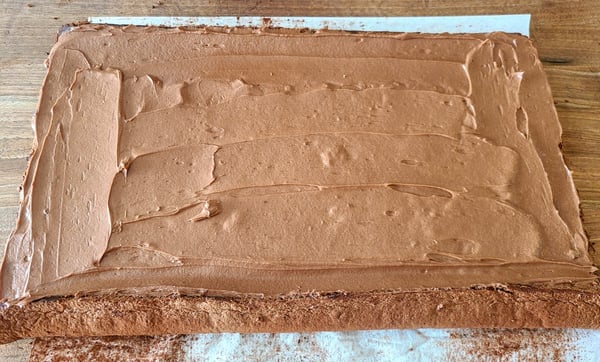 4. Roll the cake up as tightly as possible to form a 16-inch-long roll. Wrap the cake tightly in plastic and refrigerate until the ganache is firm and sliceable, at least 1-1/2 hours.
4. Roll the cake up as tightly as possible to form a 16-inch-long roll. Wrap the cake tightly in plastic and refrigerate until the ganache is firm and sliceable, at least 1-1/2 hours.
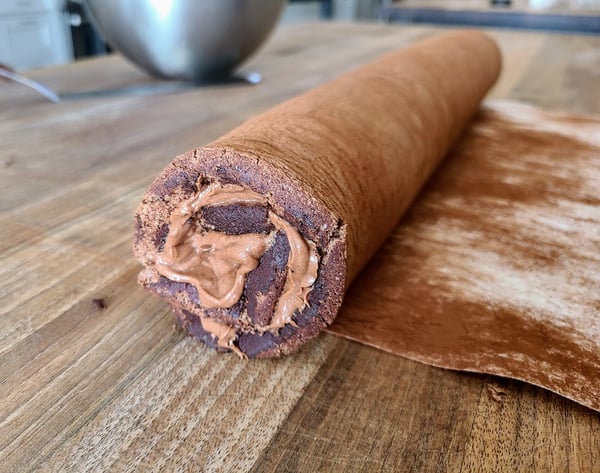 To make the white chocolate buttercream:
To make the white chocolate buttercream:
1. Place white chocolate in a small, heat-proof bowl and melt over a double boiler. Stir very well until chocolate is completely smooth and melted.
2. Set chocolate aside to cool for at least 10 minutes and no longer warm to the touch (otherwise it will melt the butter and you’ll have a greasy mess).
3. While the chocolate is cooling, place softened butter in the bowl of a stand mixer (or you may use a large bowl and an electric hand mixer) and beat until creamy and well-whipped.
4. With mixer on low-speed, gradually add melted, cooled chocolate and stir well.
5. Gradually add powdered sugar, scraping down the sides and bottom of the bowl periodically to ensure that all ingredients are well combined.
6. Sprinkle in salt and vanilla extract and stir well.
7. With mixer on low-speed, gradually add heavy cream to frosting. Gradually increase speed to high and beat for 30-60 seconds or until desired consistency is reached. It should be light, creamy, fluffy, and slightly increased in volume.
To make the dark chocolate mousse:
1. In a bowl placed over a pot of simmering water or in the microwave oven, melt the chocolate. Let cool slightly.
2. In a small bowl, sprinkle the gelatin over the water and let bloom for 5 minutes.
3. In a small saucepan over medium heat, heat 1/4 cup of the cream with the sugar until the sugar has dissolved. Remove from the heat and stir in the gelatin until completely dissolved. Add the cream mixture to the melted chocolate and stir to combine.
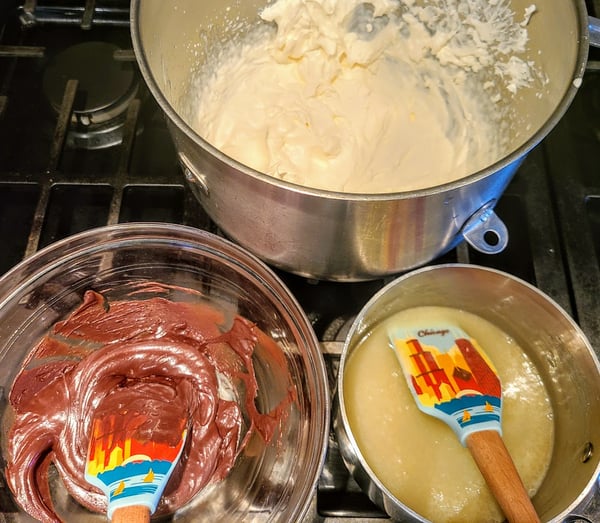 4. In another bowl, whip the remaining 2 cups cream with an electric mixer until stiff peaks form. Combine 1/2 of the whipped cream with the chocolate mixture. With a spatula, gently fold in the remaining whipped cream.
4. In another bowl, whip the remaining 2 cups cream with an electric mixer until stiff peaks form. Combine 1/2 of the whipped cream with the chocolate mixture. With a spatula, gently fold in the remaining whipped cream.
5. Fold in the cocoa nibs last.
To assemble the Charlotte:
1. Line an 8-cup dome mold or bowl with plastic wrap, leaving an overhang around the rim.
2. Set the cake on a cutting board seam side down, and using a serrated knife, trim the edges of the roll and then cut it in half. Cut each half into 1/4-inch slices, wiping the blade clean after each cut to ensure the slices of cake are clean.
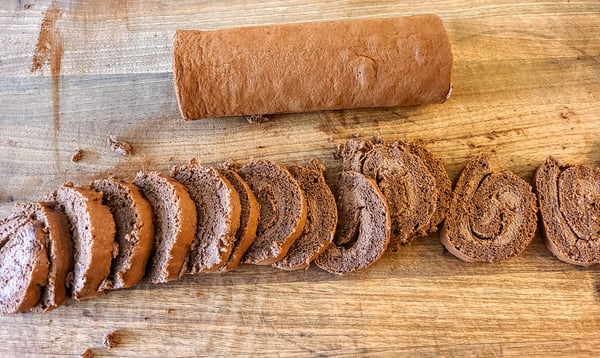 3. Put one slice in the bottom center of the mold. Next, fit a few slices around the center piece, fitting them snugly in place. Continue adding slices up the side of the mold. Line the mold completely.
3. Put one slice in the bottom center of the mold. Next, fit a few slices around the center piece, fitting them snugly in place. Continue adding slices up the side of the mold. Line the mold completely.
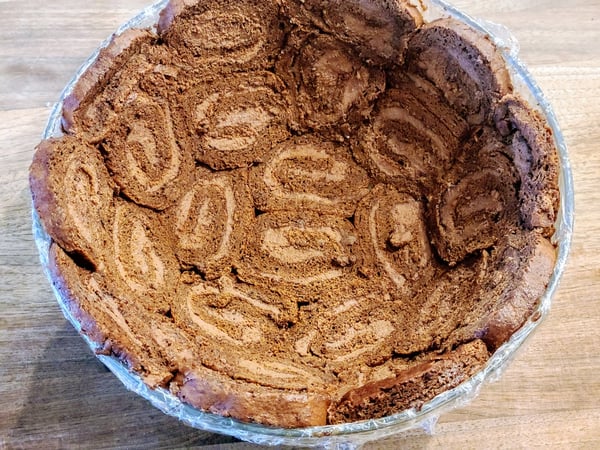 4. If the last slices reach above the rim, trim them using a sharp knife or push them so that they are flush with the rim of the mold. Reserve any remaining slices; they will be used once the mold is filled.
4. If the last slices reach above the rim, trim them using a sharp knife or push them so that they are flush with the rim of the mold. Reserve any remaining slices; they will be used once the mold is filled.
5. Using a small silicone spatula or spoon, spread the remaining ganache in an even layer over the surface of the cake slices to fully coat the interior of the mold. Cover and refrigerate until the ganache is firm, about 15 minutes.
6. Once firm, spread the white chocolate buttercream evenly over the milk chocolate ganache layer. Refrigerate for about 15 minutes.
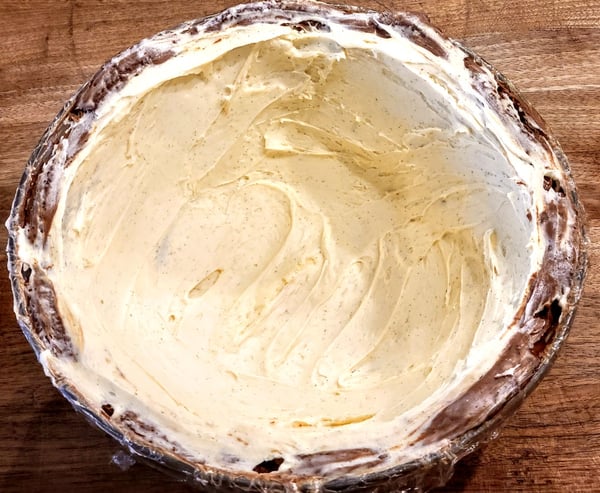 7. Pour in the dark chocolate mousse. Let chill until slightly firm about 15 minutes.
7. Pour in the dark chocolate mousse. Let chill until slightly firm about 15 minutes.
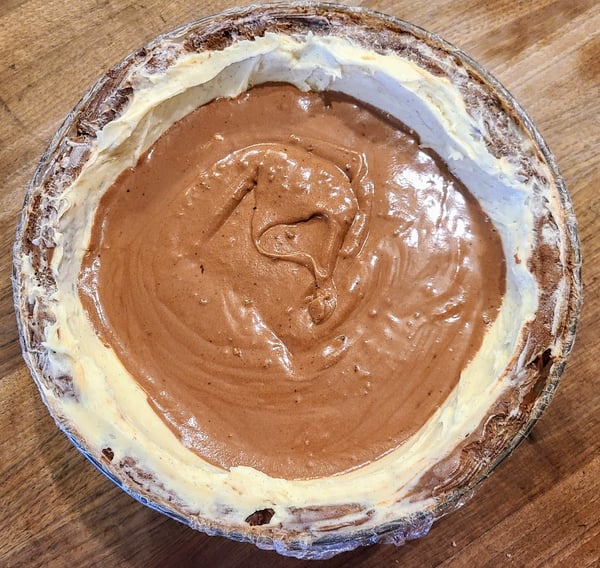 8. Take the remaining slices of roulade and place them over the mousse. Refrigerate once more until the entire cake is firm at least 2 hours.
8. Take the remaining slices of roulade and place them over the mousse. Refrigerate once more until the entire cake is firm at least 2 hours.
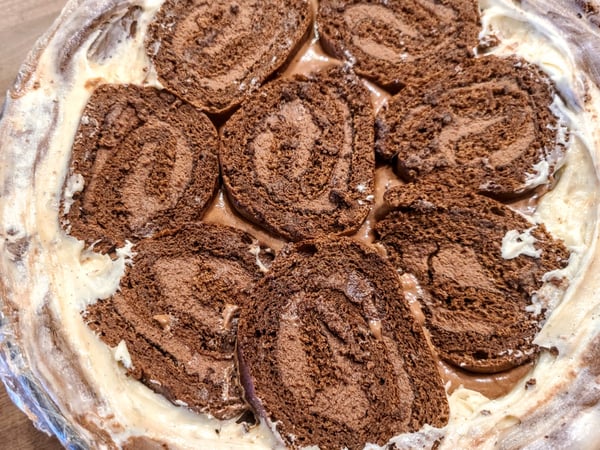 9. To unmold and serve the cake, place a cardboard round or cake plate over the top of the mold and invert. Tap on the counter to release the cake. Lift away the mold, remove the plastic wrap and serve.
9. To unmold and serve the cake, place a cardboard round or cake plate over the top of the mold and invert. Tap on the counter to release the cake. Lift away the mold, remove the plastic wrap and serve.
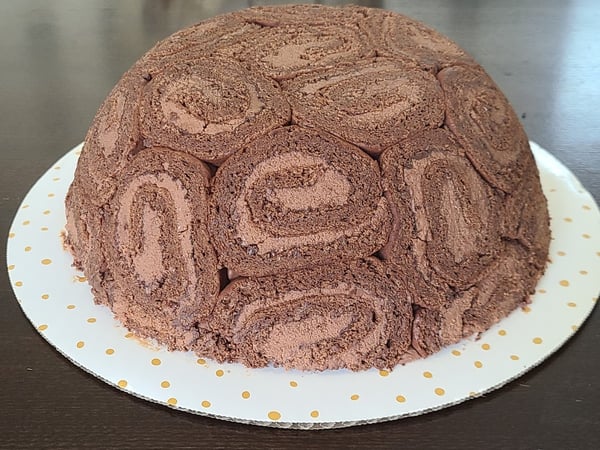 This cake has it all from cocoa powder to dark chocolate and everything in between. I enjoyed my slice with a cup of black coffee to bring out the espresso notes of the ganache. What will you pair your piece with? I would love to hear about your favorite chocolate and pairings you crave!
This cake has it all from cocoa powder to dark chocolate and everything in between. I enjoyed my slice with a cup of black coffee to bring out the espresso notes of the ganache. What will you pair your piece with? I would love to hear about your favorite chocolate and pairings you crave!
If you want to learn more about food and wine pairings we have a Summer Food and Wine Pairing class on our Lincoln Square patio on Saturday, July 10 at 6:30pm.
We also have a Virtual Custards Workshop coming up on Saturday, June 19 at 2pm CST where you can learn to make a chocolate Bavarian cream like the filling of this cake with guidance from our chefs.
If major baking undertakings like this charlotte are not your speed come and enjoy an afternoon on Sunday, July 18 of cupcakes in our new summer Cupcake Boot Camp and learn how to make new and interesting cupcake combinations. I hope to hear all about your chocolate adventures whether it is virtually, in person, or in our private TCB Facebook group!
For more chocolate-centric recipes, download our Chocolate Craze guide.
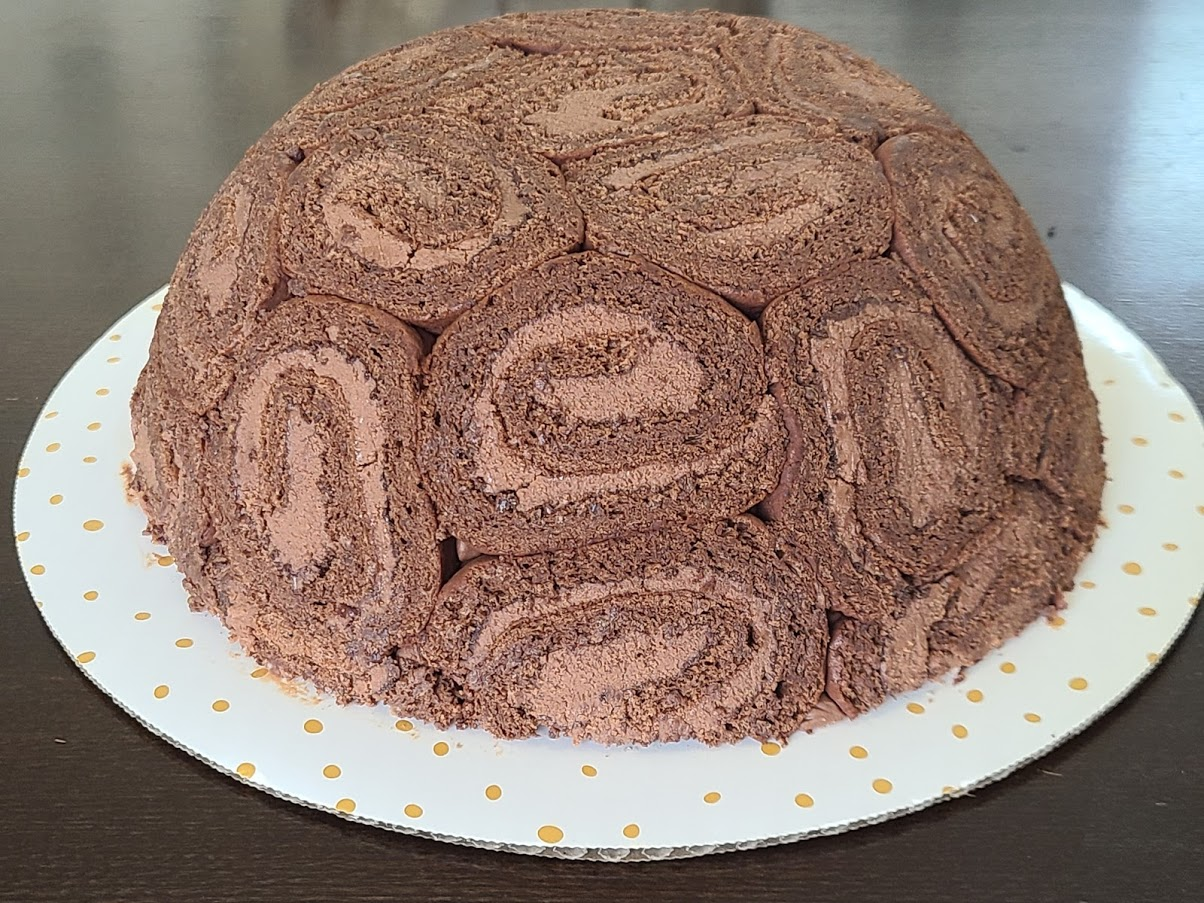
Triple Chocolate Charlotte Royale
Ingredients
- Unsalted butter, softened, for the pan
- 1 oz. (1/4 cup) unsweetened Dutch-process cocoa powder, more for dusting
- 1/2 oz. (1/3 cup) all-purpose flour
- 1/8 tsp. kosher salt
- 6 large eggs
- 1/2 cup plus 2 Tablespoons granulated sugar
- 1 teaspoon pure vanilla extract
- 10 oz. milk chocolate, finely chopped
- 2 oz. dark chocolate, preferably 85% cacao, finely chopped
- 4 oz. (8 tbs.) unsalted butter, cut into pieces
- Pinch kosher salt
- 1 cup heavy cream
- 1 Tablespoon pure vanilla extract
- 1 Tablespoon espresso liquor
- 6 oz white chocolate, chopped into small pieces
- 1 cup unsalted butter, softened to room temperature
- 2 cups powdered sugar
- 1/2 teaspoon vanilla extract
- 1/8 teaspoon salt
- 3 Tablespoons heavy cream
- 8 oz dark chocolate, chopped
- 1 teaspoon gelatin
- 2 Tablespoons water
- 1/2 cup sugar
- 2 1/4 cups heavy cream
- 1/2 cup cocoa nibs
Instructions
- Position a rack in the center of the oven and heat to 400°F. Butter a large rimmed baking sheet and line with parchment. Butter the parchment and dust with cocoa powder, shaking out the excess.
- Combine the cocoa powder, flour, and salt in a small bowl.
- Separate 3 eggs. Reserve the whites in a bowl of a stand mixer.
- Put the yolks, the remaining 3 whole eggs and 1/2 cup of the sugar in a bowl, and whisk until thick and light in color, about 5 minutes.
- Sift half of the cocoa powder mixture over the eggs. Using a large silicone spatula, fold to combine. Repeat with the remaining cocoa powder mixture.
- In a clean stand-mixer bowl with a clean whisk attachment, beat the 3 egg whites on medium speed until frothy, about 30 seconds. Add the remaining 2 Tbs. of sugar, increase the speed to medium high, and whip until medium peaks form, about 3 minutes. With a silicone spatula, fold half of the whites into the chocolate mixture to lighten. Gently fold in the remaining whites and the vanilla until the batter is evenly colored, with no streaks of white.
- Scrape the batter into the prepared pan, gently leveling it with an offset spatula.
- Bake until the cake springs back when touched in the center, about 12 minutes. Set the pan on a wire rack and allow to cool slightly.
- Run a knife between the edge of the pan and the cake. Dust the top of the cake with cocoa powder. Flip the cake onto a clean kitchen towel, peel off the parchment, and starting with a long side, roll up the cake with the towel so that you have a 16-inch-long roll. (This will help the cake roll without cracking when filled.) Let cool completely in the roll, about 30 minutes.
- Measure the 2 chocolates into a bowl. Combine the salt, butter, heavy cream and vanilla in a small saucepan and bring to a simmer over medium heat.
- Pour the hot mixture over the 2 chocolates and stir to combine until smooth. Add in the espresso liquor.
- Refrigerate uncovered until it is the consistency of thick pudding, about 25 minutes.
- Place white chocolate in a small, heat-proof bowl and melt over a double boiler. Stir very well until chocolate is completely smooth and melted.
- Set chocolate aside to cool for at least 10 minutes and no longer warm to the touch (otherwise it will melt the butter and you’ll have a greasy mess).
- While chocolate is cooling, place softened butter in the bowl of a stand mixer (or you may use a large bowl and an electric hand mixer) and beat until creamy and well-whipped.
- With mixer on low-speed, gradually add melted, cooled chocolate and stir well.
- Gradually add powdered sugar, scraping down the sides and bottom of the bowl periodically to ensure that all ingredients are well combined.
- Sprinkle in salt and vanilla extract and stir well.
- With mixer on low-speed, gradually add heavy cream to frosting. Gradually increase speed to high and beat for 30-60 seconds or until desired consistency is reached (should be light, creamy, fluffy, and slightly increased in volume.
- Line an 8-cup dome mold or bowl with plastic wrap, leaving an overhang around the rim.
- Set the cake on a cutting board seam side down, and using a serrated knife, trim the edges of the roll and then cut it in half. Cut each half into 1/4-inch slices, wiping the blade clean after each cut to ensure the slices of cake are clean.
- Put one slice in the bottom center of the mold. Next, fit a few slices around the center piece, fitting them snugly in place. Continue adding slices up the side of the mold. Line the mold completely.
- If the last slices reach above the rim, trim them using a sharp knife or push them so that they are flush with the rim of the mold. Reserve any remaining slices; they will be used once the mold is filled.
- Using a small silicone spatula or spoon, spread the remaining ganache in an even layer over the surface of the cake slices to fully coat the interior of the mold. Cover and refrigerate until the ganache is firm, about 15 minutes.
- Once firm, spread the white chocolate buttercream evenly over the milk chocolate ganache layer. Refrigerate for about 15 minutes.
- Pour in the dark chocolate mousse. Let chill until slightly firm about 15 minutes
- Take the remaining slices of roulade and place them over the mousse. Refrigerate once more until the entire cake is firm at least 2 hours.
- To unmold and serve the cake, place a cardboard round or cake plate over the top of the mold and invert. Tap on the counter to release the cake. Lift away the mold, remove the plastic wrap, and serve.


